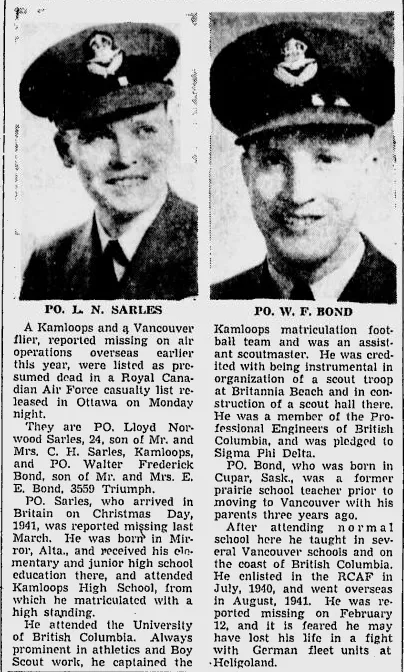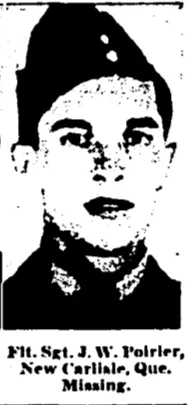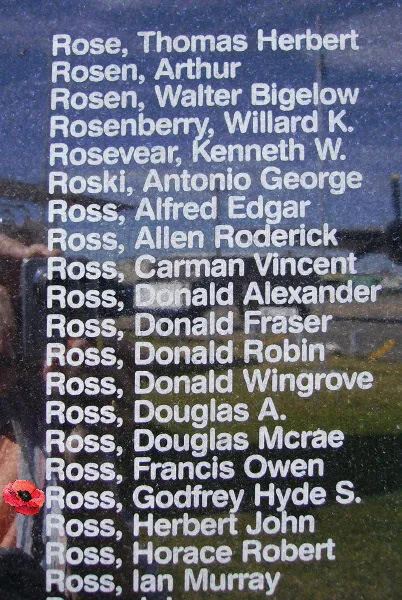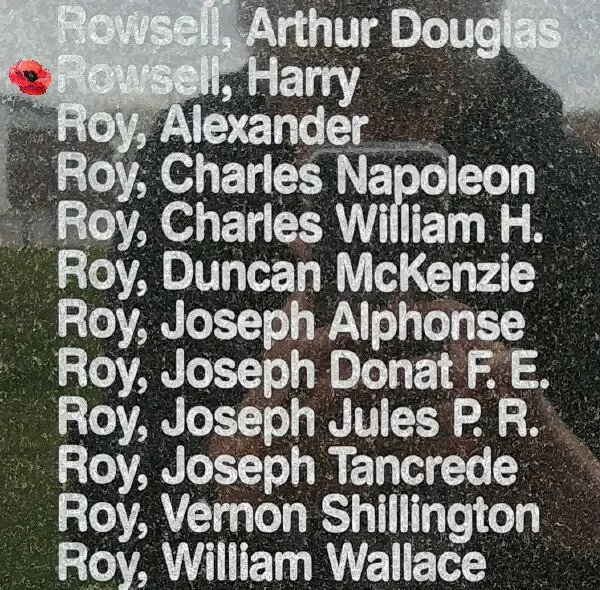Armstrong, Gordon Kenneth (Pilot Officer)
Killed in Action 1942-February-12
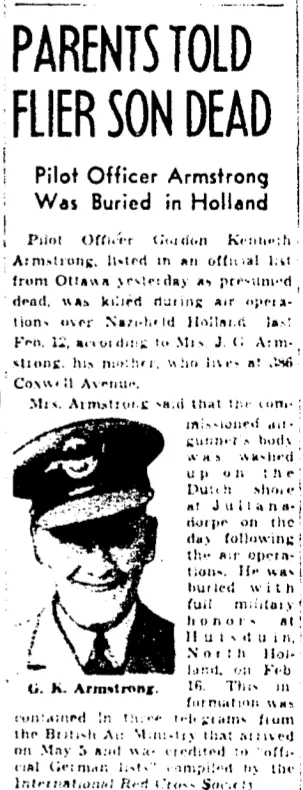

Birth Date: 1920
Born:
Parents: Son of James Gordon Armstrong and of Mary Alfretta Armstrong (nee Howlett), of Toronto, Ontario, Canada.
Spouse:
Home: Toronto, Ontario
Enlistment:
Enlistment Date: unkown date
Service
RCAF
Unit
419 (B) Sqn- Squadron
Moosa Aswayita Beware of Moose
Base
RAF Mildenhall
Rank
Pilot Officer
Position
Air Gunner
Service Numbers
J/15020
Home
Crew or Other Personnel
Wellington Z1146
Mission
Wellington Mk. IC Z1146
Bombing 1942-February-11 to 1942-February-12
419 (B) Sqn (RCAF) RAF Mildenhall
Fuller
Gerrman battle-cruisers Scharnhorst and Gneisenau and the lighter cruiser Prinz Eugen sailed from Brest to Germany through the English Channel in a carefully prepared and well-executed operation, News of the preparations did not reach Britain and the Germans chose chose a day when bad weather and low cloud gave their ships maximum concealment. A German fighter escort was provided throughout the voyage. The ships were not reported until late morning when a Spitfire of Fighter Command spotted them off Le Touquet. All available Royal Navy and R.A.F. units were ordered to attack the German ships before darkness closed in.
Most of Bomber Command was 'stood down' for the day; only 5 Group was at 4 hours' notice. The bomber squadrons made a frantic effort to prepare planes for attacks, which were mounted in 3 waves. Other aircraft of Coastal and Fighter Commands and of the Fleet Air Arm were also involved. The first Bomber Command aircraft were airborne at 1.30 p.m. and 242 sorties were flown by the squadrons before dark. Every type of aircraft available flew except the Whitleys which were stationed in the North of England. Bomber Command aircraft dispatched were: 92 Wellingtons, 64 Hampdens, 37 Blenheims, 15 Manchesters, 13 Halifaxes, II Stirlings and IO of the new American-built Boston bombers with which some of the 2 Group squadrons were being equipped, although they were not yet officially ready for operations. It was the largest Bomber Command daylight operation of the war to date.
Most of the bombers were unable to find the German ships in the poor weather conditions and, of those aircraft which did bomb, no hits were scored on these fast-moving and heavily defended targets. None of the attacks by other forces caused any serious damage to the German ships but the two largest, the Scharnhorst and the Gneisenau, were both slowed down after striking mines laid by 5 Group Hampdens or Manchesters in the Frisian Islands during recent nights. Scharnhorst hit 2 mines and Gneisenau one. All the German ships reached the safety of ports in Germany before daybreak
The sailing of these ships, although a successful operation for the Germans, finally released Bomber Command from the effort-consuming and costly requirement to bomb the ships while they had been in French ports. Bomber Command had dropped 3,413 tons of bombs on these 3 ships in recent months and lost 127 aircraft in doing so. But these raids had achieved some success. Both Scharnhorst and Gneisenau had been hit and badly damaged by bombs; this and the constant threat of further damage prevented the ships from sailing from Brest on another Atlantic shipping raid and persuaded the Germans that they should be brought back to the greater protection of German ports.
source: The Bomber Command War Diaries, Martin Middlebrook and Chris Everitt
This was another of the aircraft of the formation, and having failed to return it can only be assumed that it met a similar fate to the previously mentioned aircraft. There was 10/10ths cloud over the target area, and combined with the slight drizzle made visibility less than 1,000 yards and the attack had to be made individually.
This is one of two crews that failed to return. The crew of Wellington Z1091 (VR-A) also failed to return.
Wellington serial: Z1146
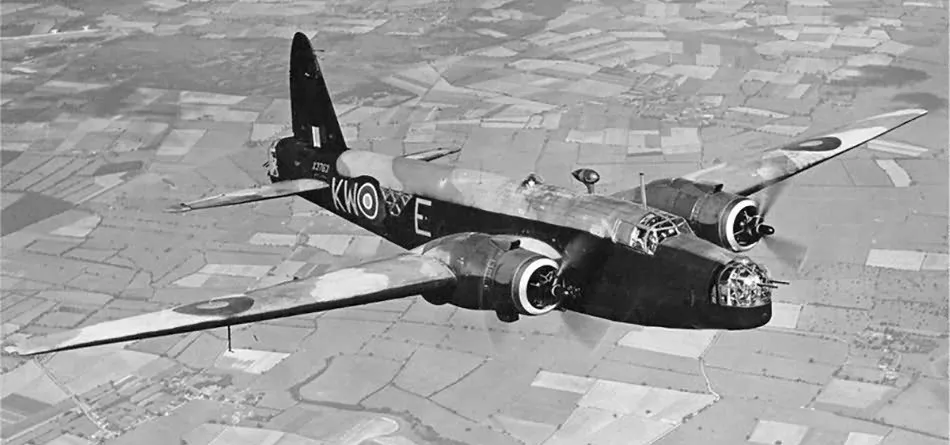
Vickers Wellington B. Mk. III (Serial No. X3763), coded KW-E, No. 425 'Alouette' (B) Squadron, RCAF, late summer of 1942
The Vickers Wellington was a British twin-engined, long-range medium bomber. It was designed during the mid-1930s at Brooklands in Weybridge, Surrey. Led by Vickers-Armstrongs' chief designer Rex Pierson, a key feature of the aircraft is its geodetic airframe fuselage structure, which was principally designed by Barnes Wallis. Development had been started in response to Air Ministry Specification B.9/32, issued in the middle of 1932, for a bomber for the Royal Air Force. This specification called for a twin-engined day bomber capable of delivering higher performance than any previous design.
The Wellington was used as a night bomber in the early years of the Second World War, performing as one of the principal bombers used by Bomber Command. During 1943, it started to be superseded as a bomber by the larger four-engined "heavies" such as the Avro Lancaster. The Wellington continued to serve throughout the war in other duties, particularly as an anti-submarine aircraft.
It holds the distinction of having been the only British bomber that was produced for the duration of the war, and of having been produced in a greater quantity than any other British-built bomber. The Wellington remained as first-line equipment when the war ended, although it had been increasingly relegated to secondary roles. The Wellington was one of two bombers named after Arthur Wellesley, 1st Duke of Wellington, the other being the Vickers Wellesley.
In August 1936, an initial order for 180 Wellington Mk I aircraft, powered by a pair of 1,050 hp (780 kW) Bristol Pegasus radial engines, was received by Vickers; it had been placed so rapidly that the order occurred prior to the first meeting intended to decide the details of the production aircraft. In October 1937, another order for a further 100 Wellington Mk Is, produced by the Gloster Aircraft Company, was issued; it was followed by an order for 100 Wellington Mk II aircraft with Rolls-Royce Merlin X V12 engines. Yet another order was placed for 64 Wellingtons produced by Armstrong Whitworth Aircraft. With this flurry of order and production having been assured by the end of 1937, Vickers set about simplifying the manufacturing process of the aircraft and announced a target of building one Wellington per day.
A total of 180 Wellington Mk I aircraft were built; 150 for the RAF and 30 for the Royal New Zealand Air Force (RNZAF) (which were transferred to the RAF on the outbreak of war and used by 75 Squadron). In October 1938, the Mk I entered service with 9 Squadron. The Wellington was initially outnumbered by the Handley Page Hampden (also ordered by the Ministry to B.9/32) and the Armstrong Whitworth Whitley (to B.34/3 for a 'night' bomber) but outlasted both rival aircraft in service. The Wellington went on to be built in 16 separate variants, in addition to two training conversions after the war. The number of Wellingtons built totalled 11,462 of all versions, a greater quantity produced than any other British bomber. On 13 October 1945, the last Wellington to be produced rolled out. Wikipedia
Unit Desciption
419 (B) Sqn Moosa Aswayita ("Moose")
History of the Squadron during World War II (Aircraft: Wellington IC, III, Halifax II, Lancaster X)
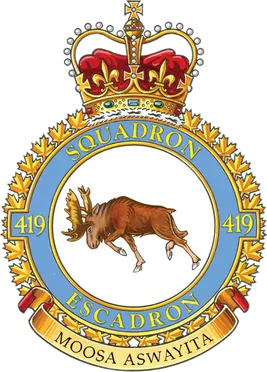
419 (Bomber) Squadron formed at RAF Mildenhall, Suffolk, UK  in 1941 as part of No 3 Group of Bomber Command. It got its name from its first commanding officer, Wing Commander John "Moose" Fulton, DSO, DFC, AFC. The squadron operated Vickers Wellington, then Handley Page Halifax and finally Avro Lancaster bombers through the course of WWII, with the squadron code letters VR. It was the third RCAF bomber unit to be formed in England. It started operations in January 1942, converting almost immediately from Wellington Mk ICs to Wellington Mk IIIs and then moving north to Leeming, Yorkshire,
in 1941 as part of No 3 Group of Bomber Command. It got its name from its first commanding officer, Wing Commander John "Moose" Fulton, DSO, DFC, AFC. The squadron operated Vickers Wellington, then Handley Page Halifax and finally Avro Lancaster bombers through the course of WWII, with the squadron code letters VR. It was the third RCAF bomber unit to be formed in England. It started operations in January 1942, converting almost immediately from Wellington Mk ICs to Wellington Mk IIIs and then moving north to Leeming, Yorkshire,  as part of 4 Group Bomber Command in August 1942. After short stays at Topcliffe
as part of 4 Group Bomber Command in August 1942. After short stays at Topcliffe  and Croft
and Croft  , it moved to Middleton St. George, County Durham
, it moved to Middleton St. George, County Durham  in November 1942, from which it flew until the end of hostilities. Here in November 1942 it was re-equipped with Halifax Mk IIs, which it flew for the next 18 months on the night offensive against Germany. In January 1943 it joined the newly formed 6 (RCAF) Group of Bomber Command.
in November 1942, from which it flew until the end of hostilities. Here in November 1942 it was re-equipped with Halifax Mk IIs, which it flew for the next 18 months on the night offensive against Germany. In January 1943 it joined the newly formed 6 (RCAF) Group of Bomber Command.
In April 1944 the squadron began to convert to the Avro Lancaster Mk X, which was produced in Canada and flown across the Atlantic. The squadron remained continuously on the offensive until 25 April 1945, when it flew its last sortie. Squadron personnel flew a total of 4,325 operational sorties during the war from Mannheim to Nuremberg, Milan to Berlin and Munich to Hanover, inflicting heavy damage on the enemy. On completion of the war in Germany, the squadron was earmarked to become part of the proposed "Tiger Force" to continue the war against Japan. However, the Japanese surrender in August 1945 led to the disbandment of the squadron in at Yarmouth, Nova Scotia  September 1945.
September 1945.
As a result of its wartime record, 419 Squadron became one of the most decorated units under the RCAF during the war. Over a span of roughly three-and-a-quarter years it logged 400 operational missions (342 bombing missions, 53 mining excursions, 3 leaflet raids and 1 "spoof") involving 4,325 sorties. A total of one hundred and twenty nine aircraft were lost on these operations. Members of the squadron accumulated 1 VC, 4 DSO's, 1 MC, 150 DFC's, 3 bars to DFC, 1 CGM, 35 DFM's: the VC was awarded posthumously to Flight Sergeant Andrew Mynarski for his attempts to help a fellow crew member escape from their burning aircraft. Battle Honours were: English Channel and North Sea 1942-44, Baltic 1942-44, Fortress Europe 1942-44, France and Germany 1944-45, Biscay Ports 1942-44, Ruhr 1942-45, Berlin 1943-44, German Ports 1942-45, Normandy 1944, Rhine, Biscay 1942; 1944. Wikipedia, Kostenuk and Griffin
![]() Squadron History (Bomber Command Museum)
Squadron History (Bomber Command Museum)
Maps for Movements of 419 Squadron 1941-45
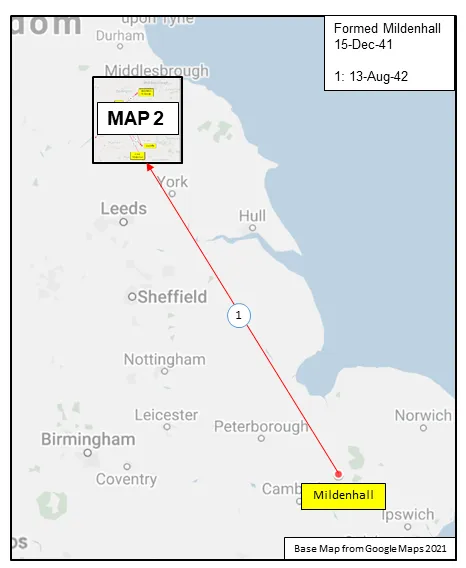
MAP 1: 419 Squadron Movements Dec 1941-Aug-42 (right-click on image to display enlarged new tab)
|
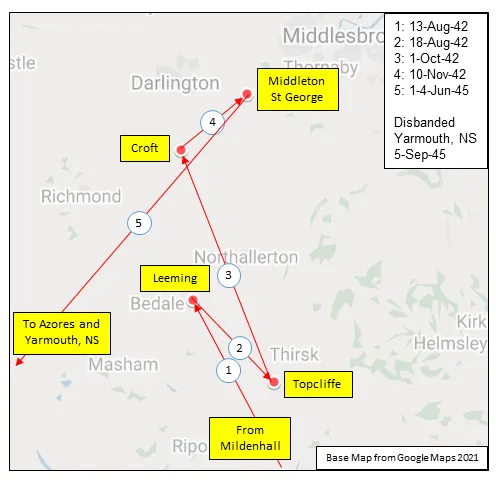
MAP 2: 419 Squadron Movements Aug 1942-Jun 1945
|
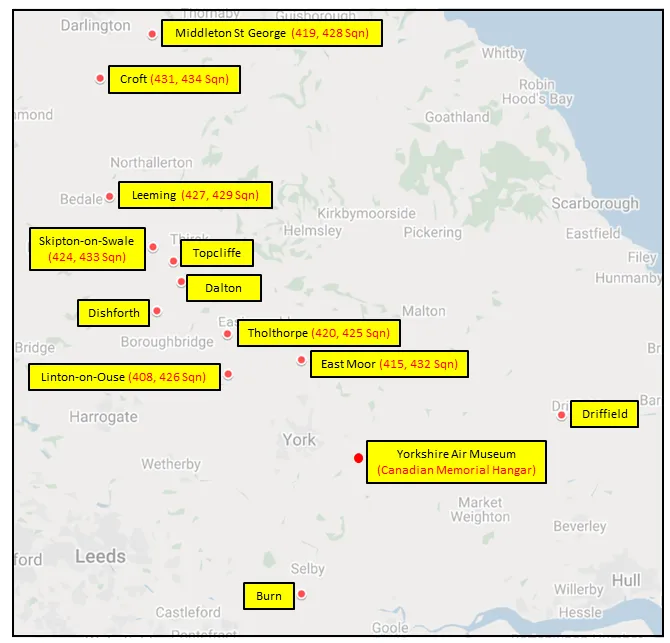
MAP 3: 6 Group Bomber Bases 1943-1945
|
419 Squadron History Summary 1941-45
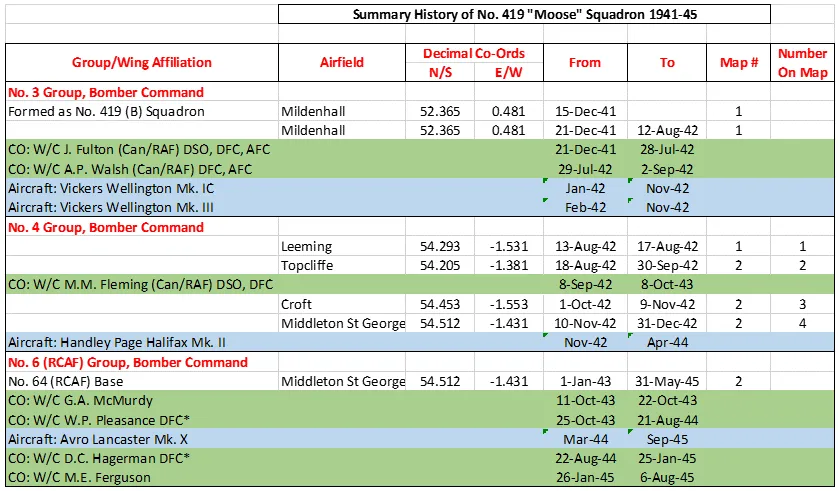
419 Squadron History Summary 1941-45 Page 2

History of the Squadron Post-WWII (Aircraft: Canuck, Silver Star, Freedom Fighter, Hornet)
The squadron was reactivated on 15 March 1954 at North Bay, Ontario  , as an all-weather fighter squadron flying the CF-100 Canuck. It moved to the NATO Air Division base at Baden-Soellingen, Germany
, as an all-weather fighter squadron flying the CF-100 Canuck. It moved to the NATO Air Division base at Baden-Soellingen, Germany  shortly after being formed. The squadron remained there until its disbandment in December 1962.
shortly after being formed. The squadron remained there until its disbandment in December 1962.
The squadron was again re-formed in December 1970, when it relocated to Cold Lake, Alberta  as No. 1 Canadian Forces Flight Training School. It initially flew the T-33 Silver Star but then transitioned to the Canadair CF-5 Freedom Fighter. The squadron was on full active duty in November 1975 but disbanded again 20 years later when the CF-5’s were retired in June 1995.
as No. 1 Canadian Forces Flight Training School. It initially flew the T-33 Silver Star but then transitioned to the Canadair CF-5 Freedom Fighter. The squadron was on full active duty in November 1975 but disbanded again 20 years later when the CF-5’s were retired in June 1995.
The squadron was again reactivated as 419 Tactical Fighter (Training) Squadron on 23 July 2000. The squadron has since conducted Phase IV of the NATO Flying Training Canada (NFTC) program for the air forces of Canada, Austria, Denmark, Italy, Hungary, Saudi Arabia, Singapore, the United Arab Emirates and the United Kingdom. This program trains basic jet pilots to become fighter pilots and prepares them for training on CF-188 class aircraft through instruction in Air-to-Air and Air-to-Ground combat tactics over a six month period.
